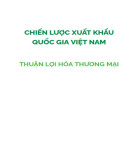
FTU Working Paper Series, Vol. 1 No. 1 (01/2022) | 65
TIỀM NĂNG VÀ THÁCH THỨC TRONG LĨNH VỰC XUẤT KHẨU THÉP
SANG THỊ TRƯỜNG CHÂU ÂU CỦA CÁC DOANH NGHIỆP VIỆT NAM
Nguyễn An Khang, Lưu Thanh Trúc
Sinh viên K59 Logistics & Quản lý chuỗi cung ứng – Viện Kinh tế và Kinh doanh quốc tế
Trường Đại học Ngoại thương, Hà Nội, Việt Nam
Nguyễn Phương Thảo, Đào Lê Khôi Nguyên
Sinh viên K59 CLC Kinh tế đối ngoại – Viện Kinh tế và Kinh doanh quốc tế
Trường Đại học Ngoại thương, Hà Nội, Việt Nam
Tóm tắt
Là thị trường đơn nhất lớn nhất thế giới và là một trong những thị trường khó tiếp cận hiệu quả
nhất, thị trường châu Âu đòi hỏi chất lượng cao, các hàng rào kỹ thuật khắt khe cũng như việc thực
thi nghiêm ngặt các tiêu chuẩn, điều kiện pháp lý, quy tắc và quy định. Hiệp định Thương mại tự
do Liên minh châu Âu - Việt Nam (EVFTA) được ký kết vào ngày 30 tháng 6 năm 2019 và có
hiệu lực từ ngày 1 tháng 8 năm 2020. Nghiên cứu của nhóm tác giả nhằm phân tích ảnh hưởng của
EVFTA đến xuất khẩu thép của Việt Nam. Sử dụng phương pháp nghiên cứu phân tích, tổng hợp
và đánh giá, nghiên cứu của chúng tôi đã có những kết quả nhất định. Kết quả cho thấy, mặc dù
việc thực hiện EVFTA tạo ra một số trở ngại đối với xuất khẩu thép của Việt Nam, nhưng về tổng
thể, hiệp định này tạo ra lợi thế cạnh tranh và thúc đẩy sự tăng trưởng của ngành luyện kim và xuất
khẩu thép của Việt Nam. Nghiên cứu đưa ra một số khuyến nghị nhằm khắc phục khó khăn và tối
đa hóa lợi ích mà hiệp định mang lại cho xuất khẩu thép của Việt Nam.
Từ khóa: EVFTA, thép, xuất khẩu thép.
POTENTIAL AND CHALLENGES IN THE FIELD OF STEEL EXPORT TO
THE EUROPEAN MARKET OF VIETNAM BUSINESSES
Abstract
As the world’s largest single market and one of the most difficult markets to access effectively,
the European market requires high quality, rigorous technical barriers as well as strict enforcement
of standards, legal conditions, rules and regulations. The European Union - Vietnam Free Trade
Agreement (EVFTA) was signed on June 30, 2019 and entered into force on August 1, 2020. This
research aims to investigate how the EVFTA affects Vietnam’s steel exports. Using the analysis,
synthesis and evaluation research method, our study has made certain findings. The results shows
that, although the implementation of EVFTA constitutes some obstacles to Vietnam’s steel
exports, in overall, the agreement creates competitive advantages and promotes the growth of
Working Paper 2022.1.1.05
- Vol 1, No 1

FTU Working Paper Series, Vol. 1 No. 1 (01/2022) | 66
Vietnam’s metallurgical industry and steel exports. Some recommendations to overcome
difficulties and maximize the benefits that the agreement brings are given in this research.
Keywords: EVFTA, steel, steel export.
1. Vietnam's steel export activities in the period of 2020 – 2021
The steel industry in recent years has had a significant growth in terms of capacity, output as
well as variety of steel types. Many businesses have invested trillions of Vietnamese Dong to
produce high-quality steel products that are popular in major markets around the world.
Vietnam's steel industry has progressed markedly in the region and played an increasingly
vital role in Southeast Asia’s steel market, making a leap in the world steel industry. According to
the “2020 World Steel in Figures” report (Basson, 2020), Vietnam ranked 14th in top 50 major
steel-producing countries 2018 and 2019 in the world, up 12 levels from 26th place in 2014
(Basson, 2015). In Southeast Asia, Vietnam was the top producer of steel, with 14.5 million tons
produced in 2018, accounting for over 30% of the region's total finished steel products output.
Vietnam was also the region's leading exporter of steel, with volumes increasing from 1 million
tons in 2010 to 6 million tons in 2018 (Cindy, 2020).
1.1. Vietnam's steel export activities in the period before the implementation of the EU -
Vietnam Free Trade Agreement (EVFTA)
In 2018, Vietnam's steel exports to most markets recorded positive growth. This growth
momentum is largely due to the stable macroeconomics, many infrastructures, construction and
real estate projects were implemented, especially the disbursement of public investment capital,
which has been focused on by the Government from the first months of 2018 (Minh, 2019).
Thuy (2018) presented data based on the statistics published by the General Department of
Customs. In the first 11 months of 2018, Vietnam's steel exports reached 5.78 million tons, worth
nearly 4.21 billion USD, a sharp increase of 36.2% in volume, up 49.5% in turnover compared to
the same period in 2017. The leading markets for Vietnam's steel consumption are the Association
of Southeast Asian Nations (ASEAN) and the American market.
The table below shows Vietnam’s steel exports to prominent markets in the first 11 months of
2018 and compares them with the figures for the same period in 2017. The table also shows the
share of these markets in the total export volume and turnover of steel.
Table 1. Vietnam’s steel exports to prominent markets in the first 11 months of 2018
Market
The first eleven months of
2018
Compared to the same
period in 2017 (%)
Proportion of steel
export (%)
Volume
(tons)
Turnover
(million USD)
Volume
Turnover
Volume
Turnover
Cambodia
1,239,198
796.71
53
74.4
21.4
18.9
America
876,666
743.84
86.2
96.2
15.2
17.6
Indonesia
610,518
477.44
11.8
20
10.6
11.3
Malaysia
561,662
388.88
58.8
79.8
9.7
9.2

FTU Working Paper Series, Vol. 1 No. 1 (01/2022) | 67
Market
The first eleven months of
2018
Compared to the same
period in 2017 (%)
Proportion of steel
export (%)
Volume
(tons)
Turnover
(million USD)
Volume
Turnover
Volume
Turnover
EU
432,559
357.06
12.2
27
7.5
8.5
Taiwan
352,893
187.76
249.1
189.3
6.1
4.5
Philippines
320,312
181.86
-22.7
-6.1
5.5
4.3
Thailand
317,229
213.5
52.8
47.3
5.5
5.1
Korea
256,673
173.32
0.6
17.4
4.4
4.1
China
6,761
8.8
-22.4
-18.5
0.1
0.2
Source: Authors synthesized based on the data of Thuy
In 2019, steel exports to most markets decreased in both volume and turnover compared to
last year. Thuy (2020) presented data based on the statistics published by the General Department
of Customs. Vietnam's steel exports reached 6.68 million tons, worth nearly 4.21 billion USD, up
6.6% in volume but down 7.4% in turnover compared to 2018.
Steel exports to America fell sharply by 57.6% in volume, down by 59.4% in turnover. This
is because in July, according to Bloomberg News (2019), the U.S. Commerce Department imposed
a tax rate of more than 400% (specifically 456.23%) on Vietnamese steel products using materials
originating from Korea and Taiwan. However, exports to China were 442,604 tons, equivalent to
192.63 million USD, and compared to the previous year, it increased very strongly by 5552% in
volume and 1849% in turnover. ASEAN, America along with China are the three largest importers
of Vietnam's steel products in 2019.
The table below shows Vietnam’s steel exports to prominent markets in 2019 and compares
them with the figures for 2018. The table also shows the share of these markets in the total export
volume and turnover of steel.
Table 2. Vietnam’s steel exports to prominent markets in 2019
Market
The year 2019
Compared to the year
2018 (%)
Proportion of steel
export (%)
Volume
(tons)
Turnover
(million USD)
Volume
Turnover
Volume
Turnover
Cambodia
1,699,253
986.75
22.9
11.6
25.4
23.4
Indonesia
873,473
574.09
27
7.8
13.1
13.6
Malaysia
744,987
458.55
23.4
9.7
11.2
10.9
China
442,604
192.63
5552
1849.1
6.6
4.6
America
383,907
313.41
-57.6
-59.4
5.7
7.4
Thailand
378,527
229.56
11.1
-0.3
5.7
5.5

FTU Working Paper Series, Vol. 1 No. 1 (01/2022) | 68
Market
The year 2019
Compared to the year
2018 (%)
Proportion of steel
export (%)
Volume
(tons)
Turnover
(million USD)
Volume
Turnover
Volume
Turnover
EU
334,468
239.31
-23.1
-34.3
5
5.7
Philippines
285,176
135.31
-14.8
-28.6
4.3
3.2
Korea
225,876
151.9
-22.5
-22.7
3.4
3.6
Taiwan
204,435
116.21
-45.4
-41.7
3.1
2.8
Source: Authors synthesized based on the data of Thuy Chung
1.2. Vietnam's steel export activities in the period under the implementation of the EU - Vietnam
Free Trade Agreement (EVFTA)
Exports in 2020 of Vietnam's steel industry faces more difficulties than in 2019 when 5 more
countries are conducting anti-dumping investigations on Vietnamese galvanized steel products and
steel pipes. In which, there are 2 countries in the market of Southeast Asia, Malaysia and the
Philippines. China and ASEAN are Vietnam's main export markets while the amount of steel
exported to the European (EU) market is still very modest even though the EVFTA has been put
into effect since August 1, 2020.
Thuy (2021) presented data based on the statistics published by the General Department of
Customs. Vietnam's steel exports reached 9.86 million tons, worth nearly 5.26 billion USD, a sharp
increase of 47.9% in volume, up 25% in turnover compared to 2019.
The table below shows Vietnam’s steel exports to prominent markets in 2020 and compares
them with the figures for 2019. The table also shows the share of these markets in the total export
volume and turnover of steel.
Table 3. Vietnam’s steel exports to prominent markets in 2020
Market
The year 2020
Compared to the year
2019 (%)
Proportion of steel
export (%)
Volume
(tons)
Turnover
(million USD)
Volume
Turnover
Volume
Turnover
China
3,537,585
1482.5
717.7
669.6
35.9
28.2
Cambodia
1,563,602
839.69
-8
-14.9
15.9
16
Thailand
675,482
390.51
82.3
72.7
6.9
7.4
Malaysia
629,419
367.97
-15.5
-19.8
6.4
7
Indonesia
551,427
338.3
-36.9
-41.1
5.6
6.4
Philippines
556,803
245.24
95.2
81.2
5.7
4.7
EU
309,000
235.5
-6,9
-1
3.13
4.5

FTU Working Paper Series, Vol. 1 No. 1 (01/2022) | 69
Market
The year 2020
Compared to the year
2019 (%)
Proportion of steel
export (%)
Volume
(tons)
Turnover
(million USD)
Volume
Turnover
Volume
Turnover
Taiwan
293,613
154.19
42.7
32.7
3
2.9
Korea
282,723
160.91
25.1
5.9
2.9
3.1
America
191,334
173.26
-50
-44.5
1.9
3.3
Source: Authors synthesized based on the data of Thuy Chung
The year 2021 has witnessed strong growth in steel exports, especially to the EU market.
Thuy (2021) presented data based on the statistics published by the General Department of
Customs. In the first 6 months of 2021, Vietnam's steel exports reached 5.88 million tons, up
50.5% compared to the same period in 2020, with a value of 4.52 billion USD, up 117% compared
to the same period in 2020. China, Cambodia, and the new factor - EU are the three largest
importers of Vietnam's steel products with a sudden high growth rate compared to the same period
in 2020.
The table below shows Vietnam’s steel exports to prominent markets in the first six months
of 2021 and compares them with the figures for the same period in 2020. The table also shows the
share of these markets in the total export volume and turnover of steel.
Table 4. Vietnam’s steel exports to prominent markets in the first six months in 2021
Market
The first six months of
2021
Compared to the same
period in 2020 (%)
Proportion of steel
export (%)
Volume
(tons)
Turnover
(million USD)
Volume
Turnover
Volume
Turnover
China
1,201,474
683.32
13.4
61.7
20.4
15.1
Cambodia
671,372
475.89
-9.8
20.6
11.4
10.5
EU
639,480
593.76
525.5
615.2
10.9
13.1
Malaysia
364,786
297.14
12.6
61.4
6.2
6.6
Indonesia
338,730
254.06
53.4
93.6
5.8
5.6
America
335,775
332.1
249.3
283.2
5.7
7.3
Thailand
304,235
243.53
1.3
49.6
5.2
5.4
Philippines
280,147
169.47
17.1
65.5
4.7
3.8
Taiwan
225,960
161.3
74.1
139.1
3.8
3.6
Korea
125,274
100.2
-10
32.2
2.1
2.2
Source: Authors synthesized based on the data of Thuy







![Chiến lược xuất khẩu quốc gia Việt Nam: Ngành điện tử [mới nhất]](https://cdn.tailieu.vn/images/document/thumbnail/2025/20250328/quyvanphi/135x160/994177032.jpg)


















